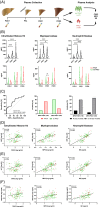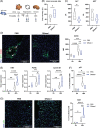Intrahepatic neutrophil accumulation and extracellular trap formation are associated with posthepatectomy liver failure
- PMID: 38099865
- PMCID: PMC10727591
- DOI: 10.1097/HC9.0000000000000348
Intrahepatic neutrophil accumulation and extracellular trap formation are associated with posthepatectomy liver failure
Abstract
Background: Posthepatectomy liver failure (PHLF) represents a life-threatening complication with limited therapeutic options. Neutrophils play a critical and dynamic role during regeneratory processes, but their role in human liver regeneration is incompletely understood, especially as underlying liver disease, detectable in the majority of patients, critically affects hepatic regeneration. Here we explored intrahepatic neutrophil accumulation and neutrophil extracellular traps (NETs) in patients with PHLF and validated the functional relevance of NETs in a murine partial hepatectomy (PHx) model.
Methods: We investigated the influx of neutrophils, macrophages, eosinophils, and mast cells and the presence of their respective extracellular traps in liver biopsies of 35 patients undergoing hepatectomy (10 patients with PHLF) before and after the initiation of liver regeneration by fluorescence microscopy. In addition, NET formation and neutrophil activation were confirmed by plasma analysis of 99 patients (24 patients with PHLF) before and up to 5 days after surgery. Furthermore, we inhibited NETs via DNase I in a murine PHx model of mice with metabolically induced liver disease.
Results: We detected rapid intrahepatic neutrophil accumulation, elevated levels of myeloperoxidase release, and NET formation in regenerating human livers, with a significantly higher increase of infiltrating neutrophils and NETs in patients with PHLF. Circulating markers of neutrophil activation, including elastase, myeloperoxidase, and citrullinated histone H3, correlated with markers of liver injury. In a murine PHx model, we showed that the inhibition of NET accelerated hepatocyte proliferation and liver regeneration.
Conclusions: Patients with PHLF showed accelerated intrahepatic neutrophil infiltration and NET formation, which were associated with liver damage. Further, we identified postsurgical myeloperoxidase levels as predictive markers for adverse outcomes and observed that blocking NETs in a murine PHx model accelerated tissue regeneration.
Copyright © 2023 The Author(s). Published by Wolters Kluwer Health, Inc. on behalf of the American Association for the Study of Liver Diseases.
Conflict of interest statement
Philipp Hohensinner received grants from OM Pharma. The remaining authors have no conflicts to report.
Figures





Comment on
-
Validation of an enzyme-linked immunosorbent assay for the quantification of citrullinated histone H3 as a marker for neutrophil extracellular traps in human plasma.Immunol Res. 2017 Jun;65(3):706-712. doi: 10.1007/s12026-017-8905-3. Immunol Res. 2017. PMID: 28161762 Free PMC article.
References
Publication types
MeSH terms
Substances
Grants and funding
LinkOut - more resources
Full Text Sources
Research Materials

